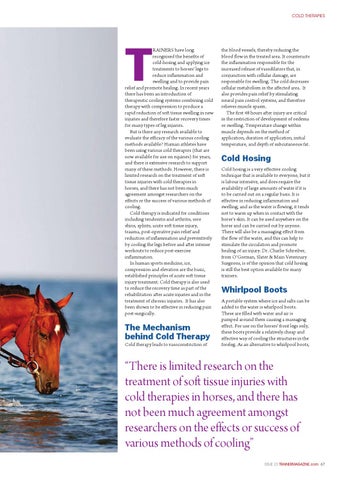Cool down.qxd:Jerkins feature.qxd
21/8/08
18:48
Page 2
COLD THERAPIES
T
RAINERS have long recognised the benefits of cold-hosing and applying ice treatments to horses’ legs to reduce inflammation and swelling and to provide pain relief and promote healing. In recent years there has been an introduction of therapeutic cooling systems combining cold therapy with compression to produce a rapid reduction of soft tissue swelling in new injuries and therefore faster recovery times for many types of leg injuries. But is there any research available to evaluate the efficacy of the various cooling methods available? Human athletes have been using various cold therapies (that are now available for use on equines) for years, and there is extensive research to support many of these methods. However, there is limited research on the treatment of soft tissue injuries with cold therapies in horses, and there has not been much agreement amongst researchers on the effects or the success of various methods of cooling. Cold therapy is indicated for conditions including tendonitis and arthritis, sore shins, splints, acute soft tissue injury, trauma, post-operative pain relief and reduction of inflammation and preventively by cooling the legs before and after intense workouts to reduce post-exercise inflammation. In human sports medicine, ice, compression and elevation are the basic, established principles of acute soft tissue injury treatment. Cold therapy is also used to reduce the recovery time as part of the rehabilitation after acute injuries and in the treatment of chronic injuries. It has also been shown to be effective in reducing pain post-surgically.
The Mechanism behind Cold Therapy Cold therapy leads to vasoconstriction of
the blood vessels, thereby reducing the blood flow in the treated area. It counteracts the inflammation responsible for the increased release of vasodilators that, in conjunction with cellular damage, are responsible for swelling. The cold decreases cellular metabolism in the affected area. It also provides pain relief by stimulating neural pain control systems, and therefore relieves muscle spasm. The first 48 hours after injury are critical in the restriction of development of oedema or swelling. Temperature change within muscle depends on the method of application, duration of application, initial temperature, and depth of subcutaneous fat.
Cold Hosing Cold hosing is a very effective cooling technique that is available to everyone, but it is labour intensive, and does require the availability of large amounts of water if it is to be carried out on a regular basis. It is effective in reducing inflammation and swelling, and as the water is flowing, it tends not to warm up when in contact with the horse’s skin. It can be used anywhere on the horse and can be carried out by anyone. There will also be a massaging effect from the flow of the water, and this can help to stimulate the circulation and promote healing of an injury. Dr. Charlie Schreiber, from O’Gorman, Slater & Main Veterinary Surgeons, is of the opinion that cold hosing is still the best option available for many trainers.
Whirlpool Boots A portable system where ice and salts can be added to the water is whirlpool boots. These are filled with water and air is pumped around them causing a massaging effect. For use on the horses’ front legs only, these boots provide a relatively cheap and effective way of cooling the structures in the foreleg. As an alternative to whirlpool boots,
“There is limited research on the treatment of soft tissue injuries with cold therapies in horses, and there has not been much agreement amongst researchers on the effects or success of various methods of cooling” ISSUE 23 TRAINERMAGAZINE.com 67
